wheel SKODA FABIA 2013 2.G / 5J Owner's Guide
[x] Cancel search | Manufacturer: SKODA, Model Year: 2013, Model line: FABIA, Model: SKODA FABIA 2013 2.G / 5JPages: 223, PDF Size: 12.77 MB
Page 129 of 223
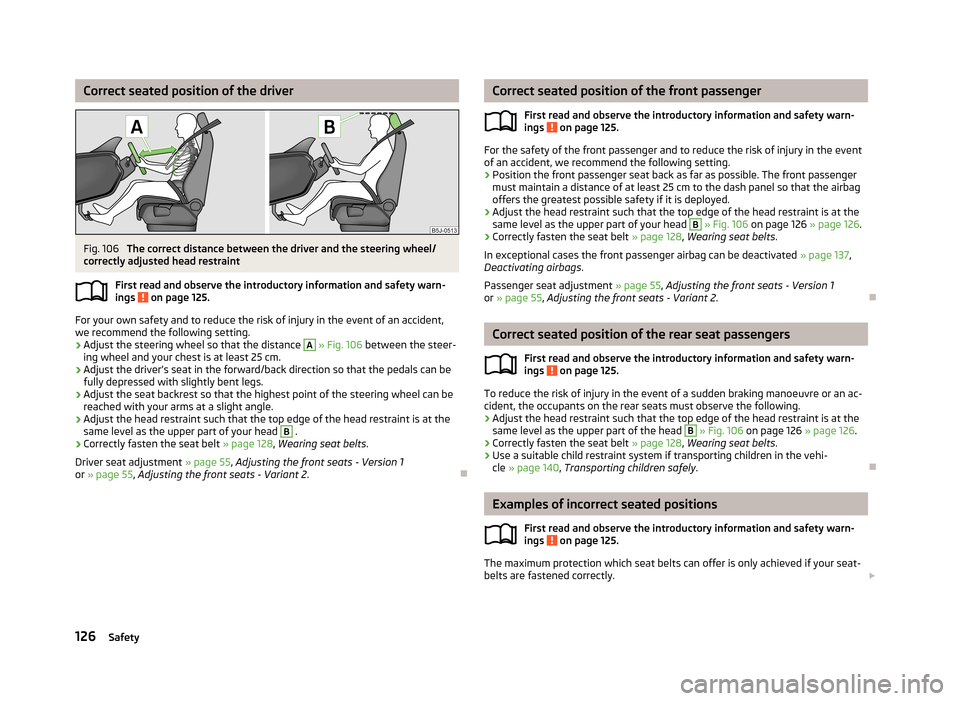
Correct seated position of the driverFig. 106
The correct distance between the driver and the steering wheel/
correctly adjusted head restraint
First read and observe the introductory information and safety warn-ings
on page 125.
For your own safety and to reduce the risk of injury in the event of an accident,
we recommend the following setting.
› Adjust the steering wheel so that the distance
A
» Fig. 106 between the steer-
ing wheel and your chest is at least 25 cm.
› Adjust the driver’s seat in the forward/back direction so that the pedals can be
fully depressed with slightly bent legs.
› Adjust the seat backrest so that the highest point of the steering wheel can be
reached with your arms at a slight angle.
› Adjust the head restraint such that the top edge of the head restraint is at the
same level as the upper part of your head
B
.
› Correctly fasten the seat belt
» page 128, Wearing seat belts .
Driver seat adjustment » page 55, Adjusting the front seats - Version 1
or » page 55 , Adjusting the front seats - Variant 2 .
Correct seated position of the front passenger
First read and observe the introductory information and safety warn-ings
on page 125.
For the safety of the front passenger and to reduce the risk of injury in the event
of an accident, we recommend the following setting.
› Position the front passenger seat back as far as possible. The front passenger
must maintain a distance of at least 25 cm to the dash panel so that the airbag
offers the greatest possible safety if it is deployed.
› Adjust the head restraint such that the top edge of the head restraint is at the
same level as the upper part of your head
B
» Fig. 106 on page 126 » page 126.
› Correctly fasten the seat belt
» page 128, Wearing seat belts .
In exceptional cases the front passenger airbag can be deactivated » page 137,
Deactivating airbags .
Passenger seat adjustment » page 55, Adjusting the front seats - Version 1
or » page 55 , Adjusting the front seats - Variant 2 .
Correct seated position of the rear seat passengers
First read and observe the introductory information and safety warn-ings
on page 125.
To reduce the risk of injury in the event of a sudden braking manoeuvre or an ac-
cident, the occupants on the rear seats must observe the following.
› Adjust the head restraint such that the top edge of the head restraint is at the
same level as the upper part of the head
B
» Fig. 106 on page 126 » page 126.
› Correctly fasten the seat belt
» page 128, Wearing seat belts .
› Use a suitable child restraint system if transporting children in the vehi-
cle » page 140 , Transporting children safely .
Examples of incorrect seated positions
First read and observe the introductory information and safety warn-
ings
on page 125.
The maximum protection which seat belts can offer is only achieved if your seat-
belts are fastened correctly.
126Safety
Page 132 of 223
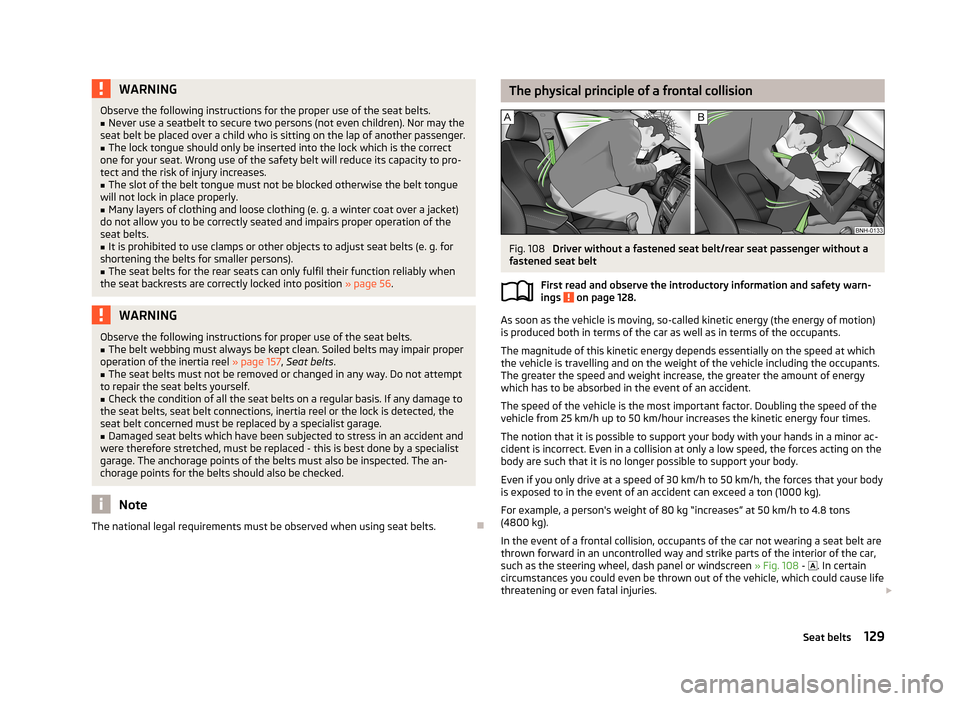
WARNINGObserve the following instructions for the proper use of the seat belts.■Never use a seatbelt to secure two persons (not even children). Nor may the
seat belt be placed over a child who is sitting on the lap of another passenger.■
The lock tongue should only be inserted into the lock which is the correct
one for your seat. Wrong use of the safety belt will reduce its capacity to pro-
tect and the risk of injury increases.
■
The slot of the belt tongue must not be blocked otherwise the belt tongue
will not lock in place properly.
■
Many layers of clothing and loose clothing (e. g. a winter coat over a jacket)
do not allow you to be correctly seated and impairs proper operation of the
seat belts.
■
It is prohibited to use clamps or other objects to adjust seat belts (e. g. for
shortening the belts for smaller persons).
■
The seat belts for the rear seats can only fulfil their function reliably when
the seat backrests are correctly locked into position » page 56.
WARNINGObserve the following instructions for proper use of the seat belts.■The belt webbing must always be kept clean. Soiled belts may impair proper
operation of the inertia reel » page 157, Seat belts .■
The seat belts must not be removed or changed in any way. Do not attempt
to repair the seat belts yourself.
■
Check the condition of all the seat belts on a regular basis. If any damage to
the seat belts, seat belt connections, inertia reel or the lock is detected, the
seat belt concerned must be replaced by a specialist garage.
■
Damaged seat belts which have been subjected to stress in an accident and
were therefore stretched, must be replaced - this is best done by a specialist
garage. The anchorage points of the belts must also be inspected. The an-
chorage points for the belts should also be checked.
Note
The national legal requirements must be observed when using seat belts.
The physical principle of a frontal collisionFig. 108
Driver without a fastened seat belt/rear seat passenger without a
fastened seat belt
First read and observe the introductory information and safety warn-ings
on page 128.
As soon as the vehicle is moving, so-called kinetic energy (the energy of motion)
is produced both in terms of the car as well as in terms of the occupants.
The magnitude of this kinetic energy depends essentially on the speed at which
the vehicle is travelling and on the weight of the vehicle including the occupants.
The greater the speed and weight increase, the greater the amount of energy
which has to be absorbed in the event of an accident.
The speed of the vehicle is the most important factor. Doubling the speed of the
vehicle from 25 km/h up to 50 km/hour increases the kinetic energy four times.
The notion that it is possible to support your body with your hands in a minor ac-cident is incorrect. Even in a collision at only a low speed, the forces acting on thebody are such that it is no longer possible to support your body.
Even if you only drive at a speed of 30 km/h to 50 km/h, the forces that your body is exposed to in the event of an accident can exceed a ton (1000 kg).
For example, a person's weight of 80 kg “increases” at 50 km/h to 4.8 tons
(4800 kg).
In the event of a frontal collision, occupants of the car not wearing a seat belt are
thrown forward in an uncontrolled way and strike parts of the interior of the car,
such as the steering wheel, dash panel or windscreen » Fig. 108 -
. In certain
circumstances you could even be thrown out of the vehicle, which could cause life threatening or even fatal injuries.
129Seat belts
Page 136 of 223
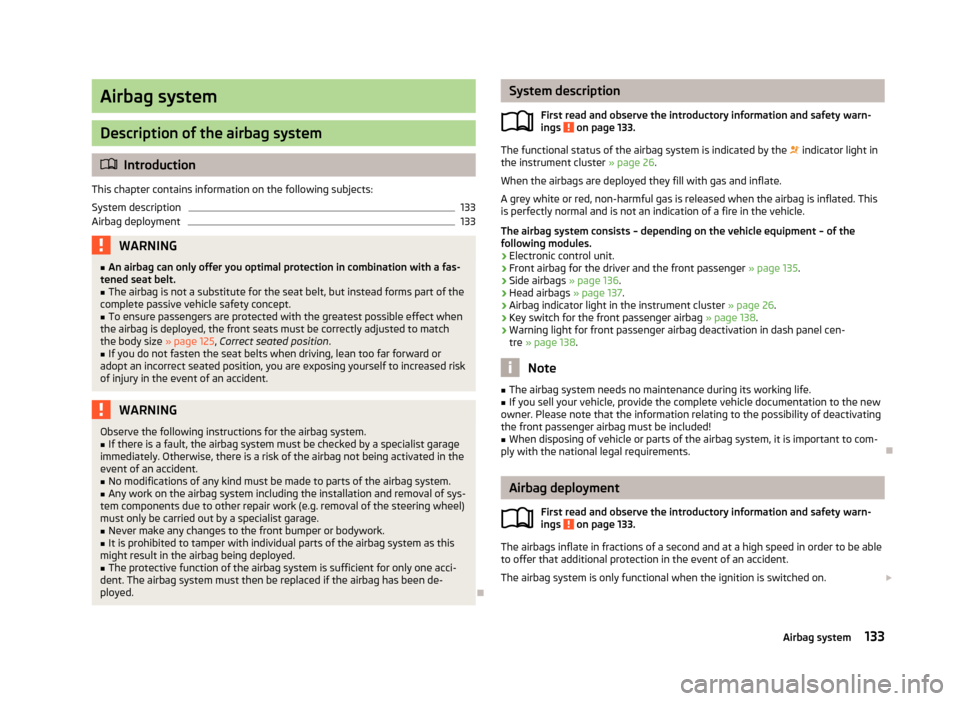
Airbag system
Description of the airbag system
Introduction
This chapter contains information on the following subjects:
System description
133
Airbag deployment
133WARNING■ An airbag can only offer you optimal protection in combination with a fas-
tened seat belt.■
The airbag is not a substitute for the seat belt, but instead forms part of the
complete passive vehicle safety concept.
■
To ensure passengers are protected with the greatest possible effect when
the airbag is deployed, the front seats must be correctly adjusted to match
the body size » page 125, Correct seated position .
■
If you do not fasten the seat belts when driving, lean too far forward or
adopt an incorrect seated position, you are exposing yourself to increased risk of injury in the event of an accident.
WARNINGObserve the following instructions for the airbag system.■If there is a fault, the airbag system must be checked by a specialist garage
immediately. Otherwise, there is a risk of the airbag not being activated in the
event of an accident.■
No modifications of any kind must be made to parts of the airbag system.
■
Any work on the airbag system including the installation and removal of sys-
tem components due to other repair work (e.g. removal of the steering wheel) must only be carried out by a specialist garage.
■
Never make any changes to the front bumper or bodywork.
■
It is prohibited to tamper with individual parts of the airbag system as this
might result in the airbag being deployed.
■
The protective function of the airbag system is sufficient for only one acci-
dent. The airbag system must then be replaced if the airbag has been de-
ployed.
System description
First read and observe the introductory information and safety warn-ings
on page 133.
The functional status of the airbag system is indicated by the indicator light in
the instrument cluster » page 26.
When the airbags are deployed they fill with gas and inflate.
A grey white or red, non-harmful gas is released when the airbag is inflated. This
is perfectly normal and is not an indication of a fire in the vehicle.
The airbag system consists – depending on the vehicle equipment – of thefollowing modules.
› Electronic control unit.
› Front airbag for the driver and the front passenger
» page 135.
› Side airbags
» page 136.
› Head airbags
» page 137.
› Airbag indicator light in the instrument cluster
» page 26.
› Key switch for the front passenger airbag
» page 138.
› Warning light for front passenger airbag deactivation in dash panel cen-
tre » page 138 .
Note
■
The airbag system needs no maintenance during its working life.■If you sell your vehicle, provide the complete vehicle documentation to the new
owner. Please note that the information relating to the possibility of deactivating
the front passenger airbag must be included!■
When disposing of vehicle or parts of the airbag system, it is important to com-
ply with the national legal requirements.
Airbag deployment
First read and observe the introductory information and safety warn-
ings
on page 133.
The airbags inflate in fractions of a second and at a high speed in order to be able
to offer that additional protection in the event of an accident.
The airbag system is only functional when the ignition is switched on.
133Airbag system
Page 138 of 223
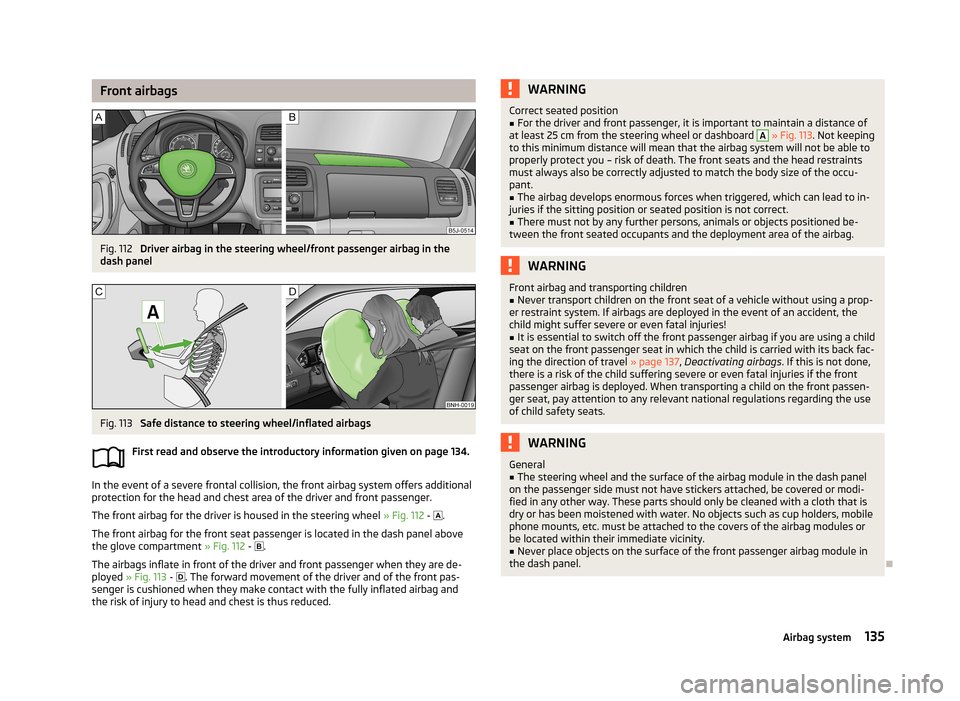
Front airbagsFig. 112
Driver airbag in the steering wheel/front passenger airbag in the
dash panel
Fig. 113
Safe distance to steering wheel/inflated airbags
First read and observe the introductory information given on page 134.
In the event of a severe frontal collision, the front airbag system offers additional protection for the head and chest area of the driver and front passenger.
The front airbag for the driver is housed in the steering wheel » Fig. 112 -
.
The front airbag for the front seat passenger is located in the dash panel above
the glove compartment » Fig. 112 -
.
The airbags inflate in front of the driver and front passenger when they are de- ployed » Fig. 113 -
. The forward movement of the driver and of the front pas-
senger is cushioned when they make contact with the fully inflated airbag and
the risk of injury to head and chest is thus reduced.
WARNINGCorrect seated position■For the driver and front passenger, it is important to maintain a distance of
at least 25 cm from the steering wheel or dashboard A
» Fig. 113 . Not keeping
to this minimum distance will mean that the airbag system will not be able to
properly protect you – risk of death. The front seats and the head restraints
must always also be correctly adjusted to match the body size of the occu-
pant.
■
The airbag develops enormous forces when triggered, which can lead to in-
juries if the sitting position or seated position is not correct.
■
There must not by any further persons, animals or objects positioned be-
tween the front seated occupants and the deployment area of the airbag.
WARNINGFront airbag and transporting children■Never transport children on the front seat of a vehicle without using a prop-
er restraint system. If airbags are deployed in the event of an accident, the
child might suffer severe or even fatal injuries!■
It is essential to switch off the front passenger airbag if you are using a child
seat on the front passenger seat in which the child is carried with its back fac-
ing the direction of travel » page 137, Deactivating airbags . If this is not done,
there is a risk of the child suffering severe or even fatal injuries if the front
passenger airbag is deployed. When transporting a child on the front passen-
ger seat, pay attention to any relevant national regulations regarding the use
of child safety seats.
WARNINGGeneral■The steering wheel and the surface of the airbag module in the dash panel
on the passenger side must not have stickers attached, be covered or modi-
fied in any other way. These parts should only be cleaned with a cloth that is
dry or has been moistened with water. No objects such as cup holders, mobile
phone mounts, etc. must be attached to the covers of the airbag modules or
be located within their immediate vicinity.■
Never place objects on the surface of the front passenger airbag module in
the dash panel.
135Airbag system
Page 141 of 223
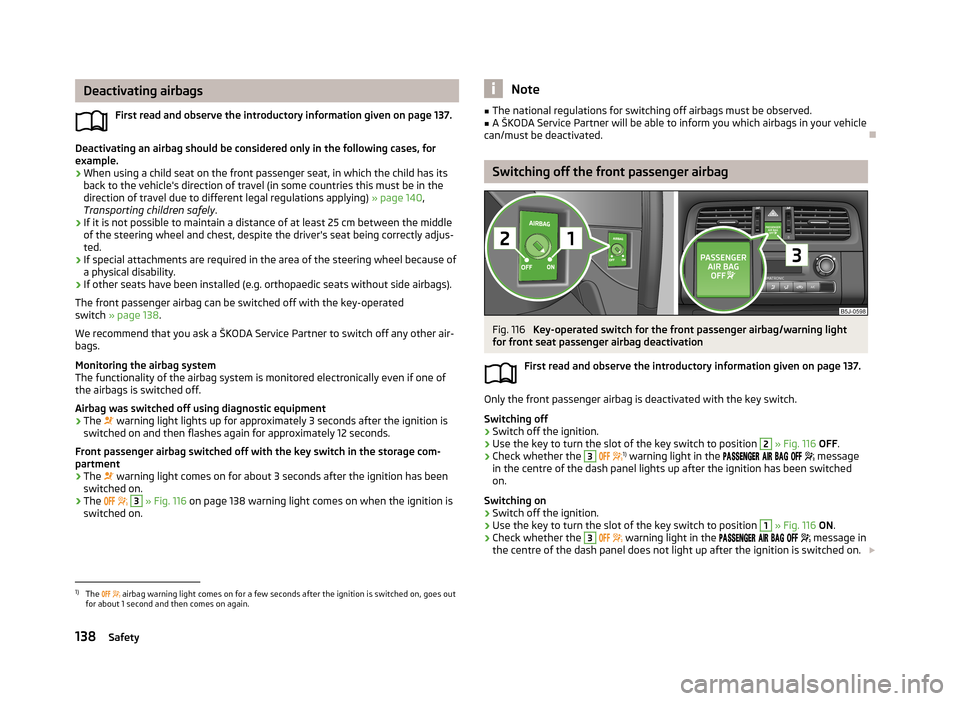
Deactivating airbagsFirst read and observe the introductory information given on page 137.
Deactivating an airbag should be considered only in the following cases, for
example.
› When using a child seat on the front passenger seat, in which the child has its
back to the vehicle's direction of travel (in some countries this must be in the direction of travel due to different legal regulations applying) » page 140,
Transporting children safely .
› If it is not possible to maintain a distance of at least 25 cm between the middle
of the steering wheel and chest, despite the driver's seat being correctly adjus-
ted.
› If special attachments are required in the area of the steering wheel because of
a physical disability.
› If other seats have been installed (e.g. orthopaedic seats without side airbags).
The front passenger airbag can be switched off with the key-operated
switch » page 138 .
We recommend that you ask a ŠKODA Service Partner to switch off any other air-
bags.
Monitoring the airbag system
The functionality of the airbag system is monitored electronically even if one of
the airbags is switched off.
Airbag was switched off using diagnostic equipment
› The
warning light lights up for approximately 3 seconds after the ignition is
switched on and then flashes again for approximately 12 seconds.
Front passenger airbag switched off with the key switch in the storage com- partment
› The
warning light comes on for about 3 seconds after the ignition has been
switched on.
› The
3
» Fig. 116 on page 138 warning light comes on when the ignition is
switched on.
Note■ The national regulations for switching off airbags must be observed.■A ŠKODA Service Partner will be able to inform you which airbags in your vehicle
can/must be deactivated.
Switching off the front passenger airbag
Fig. 116
Key-operated switch for the front passenger airbag/warning light
for front seat passenger airbag deactivation
First read and observe the introductory information given on page 137.
Only the front passenger airbag is deactivated with the key switch.
Switching off
›
Switch off the ignition.
›
Use the key to turn the slot of the key switch to position
2
» Fig. 116 OFF .
›
Check whether the
3
1)
warning light in the
message
in the centre of the dash panel lights up after the ignition has been switched
on.
Switching on
›
Switch off the ignition.
›
Use the key to turn the slot of the key switch to position
1
» Fig. 116 ON .
›
Check whether the
3
warning light in the
message in
the centre of the dash panel does not light up after the ignition is switched on.
1)
The
airbag warning light comes on for a few seconds after the ignition is switched on, goes out
for about 1 second and then comes on again.
138Safety
Page 152 of 223
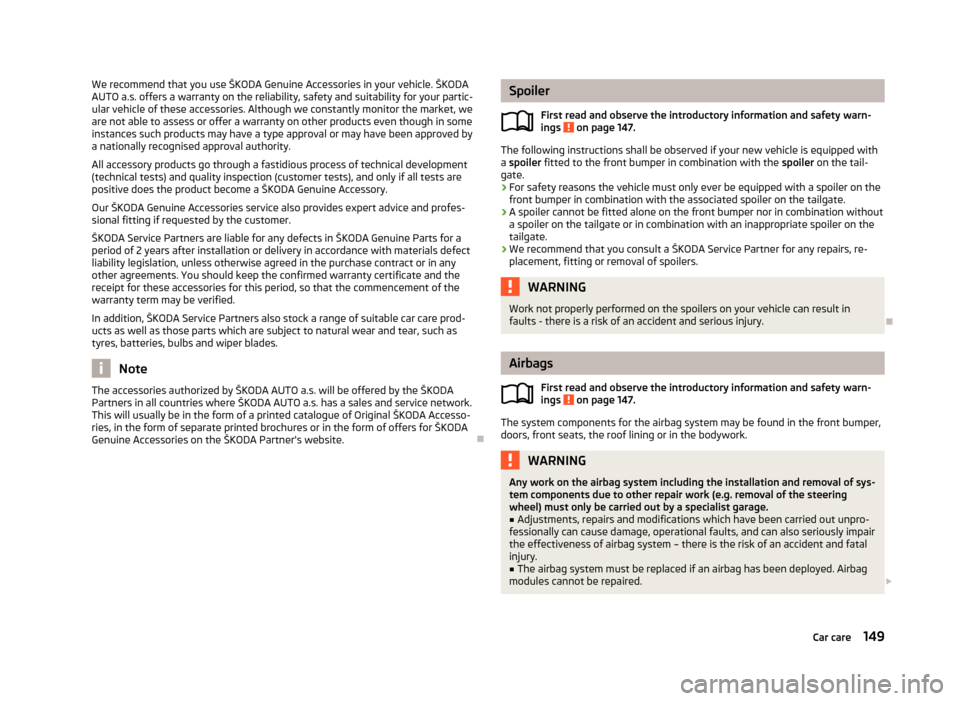
We recommend that you use ŠKODA Genuine Accessories in your vehicle. ŠKODA
AUTO a.s. offers a warranty on the reliability, safety and suitability for your partic-
ular vehicle of these accessories. Although we constantly monitor the market, we
are not able to assess or offer a warranty on other products even though in some
instances such products may have a type approval or may have been approved by
a nationally recognised approval authority.
All accessory products go through a fastidious process of technical development(technical tests) and quality inspection (customer tests), and only if all tests are positive does the product become a ŠKODA Genuine Accessory.
Our ŠKODA Genuine Accessories service also provides expert advice and profes-
sional fitting if requested by the customer.
ŠKODA Service Partners are liable for any defects in ŠKODA Genuine Parts for a period of 2 years after installation or delivery in accordance with materials defectliability legislation, unless otherwise agreed in the purchase contract or in any
other agreements. You should keep the confirmed warranty certificate and the
receipt for these accessories for this period, so that the commencement of the
warranty term may be verified.
In addition, ŠKODA Service Partners also stock a range of suitable car care prod-
ucts as well as those parts which are subject to natural wear and tear, such as
tyres, batteries, bulbs and wiper blades.
Note
The accessories authorized by ŠKODA AUTO a.s. will be offered by the ŠKODA
Partners in all countries where ŠKODA AUTO a.s. has a sales and service network.
This will usually be in the form of a printed catalogue of Original ŠKODA Accesso-
ries, in the form of separate printed brochures or in the form of offers for ŠKODA
Genuine Accessories on the ŠKODA Partner's website.
Spoiler
First read and observe the introductory information and safety warn-ings
on page 147.
The following instructions shall be observed if your new vehicle is equipped with
a spoiler fitted to the front bumper in combination with the spoiler on the tail-
gate.
› For safety reasons the vehicle must only ever be equipped with a spoiler on the
front bumper in combination with the associated spoiler on the tailgate.
› A spoiler cannot be fitted alone on the front bumper nor in combination without
a spoiler on the tailgate or in combination with an inappropriate spoiler on the
tailgate.
› We recommend that you consult a ŠKODA Service Partner for any repairs, re-
placement, fitting or removal of spoilers.
WARNINGWork not properly performed on the spoilers on your vehicle can result in faults - there is a risk of an accident and serious injury.
Airbags
First read and observe the introductory information and safety warn-
ings
on page 147.
The system components for the airbag system may be found in the front bumper,
doors, front seats, the roof lining or in the bodywork.
WARNINGAny work on the airbag system including the installation and removal of sys-
tem components due to other repair work (e.g. removal of the steering wheel) must only be carried out by a specialist garage.■
Adjustments, repairs and modifications which have been carried out unpro-
fessionally can cause damage, operational faults, and can also seriously impair
the effectiveness of airbag system – there is the risk of an accident and fatal
injury.
■
The airbag system must be replaced if an airbag has been deployed. Airbag
modules cannot be repaired.
149Car care
Page 153 of 223
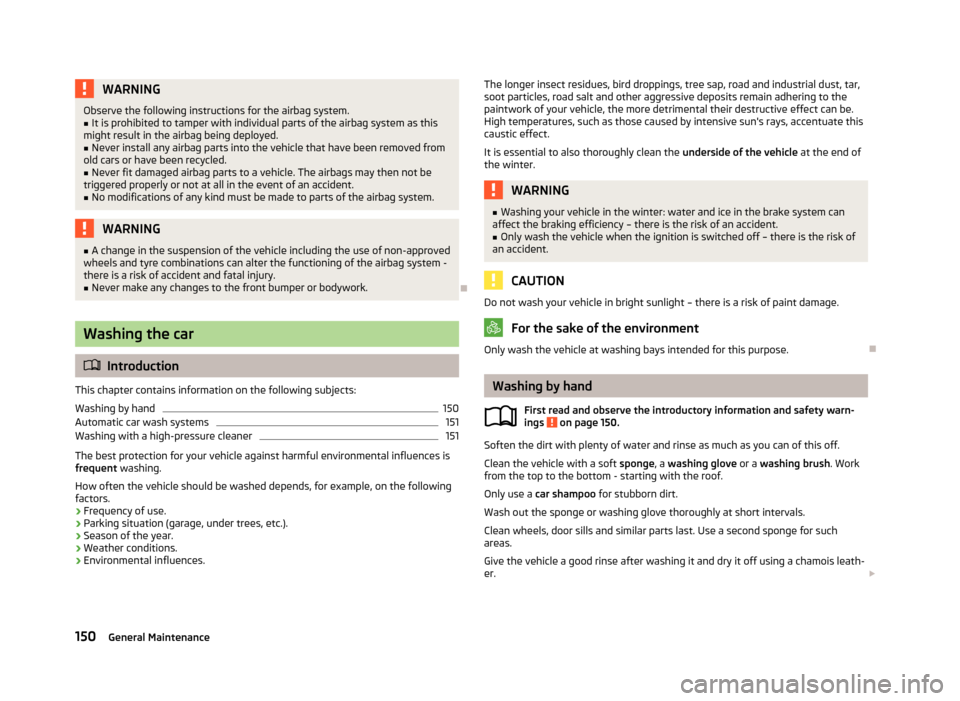
WARNINGObserve the following instructions for the airbag system.■It is prohibited to tamper with individual parts of the airbag system as this
might result in the airbag being deployed.■
Never install any airbag parts into the vehicle that have been removed from
old cars or have been recycled.
■
Never fit damaged airbag parts to a vehicle. The airbags may then not be
triggered properly or not at all in the event of an accident.
■
No modifications of any kind must be made to parts of the airbag system.
WARNING■ A change in the suspension of the vehicle including the use of non-approved
wheels and tyre combinations can alter the functioning of the airbag system -
there is a risk of accident and fatal injury.■
Never make any changes to the front bumper or bodywork.
Washing the car
Introduction
This chapter contains information on the following subjects:
Washing by hand
150
Automatic car wash systems
151
Washing with a high-pressure cleaner
151
The best protection for your vehicle against harmful environmental influences is
frequent washing.
How often the vehicle should be washed depends, for example, on the following
factors.
› Frequency of use.
› Parking situation (garage, under trees, etc.).
› Season of the year.
› Weather conditions.
› Environmental influences.
The longer insect residues, bird droppings, tree sap, road and industrial dust, tar,
soot particles, road salt and other aggressive deposits remain adhering to the
paintwork of your vehicle, the more detrimental their destructive effect can be.
High temperatures, such as those caused by intensive sun's rays, accentuate this
caustic effect.
It is essential to also thoroughly clean the underside of the vehicle at the end of
the winter.WARNING■ Washing your vehicle in the winter: water and ice in the brake system can
affect the braking efficiency – there is the risk of an accident.■
Only wash the vehicle when the ignition is switched off – there is the risk of
an accident.
CAUTION
Do not wash your vehicle in bright sunlight – there is a risk of paint damage.
For the sake of the environment
Only wash the vehicle at washing bays intended for this purpose.
Washing by hand
First read and observe the introductory information and safety warn-
ings
on page 150.
Soften the dirt with plenty of water and rinse as much as you can of this off.
Clean the vehicle with a soft sponge, a washing glove or a washing brush . Work
from the top to the bottom - starting with the roof.
Only use a car shampoo for stubborn dirt.
Wash out the sponge or washing glove thoroughly at short intervals.
Clean wheels, door sills and similar parts last. Use a second sponge for such
areas.
Give the vehicle a good rinse after washing it and dry it off using a chamois leath- er.
150General Maintenance
Page 154 of 223
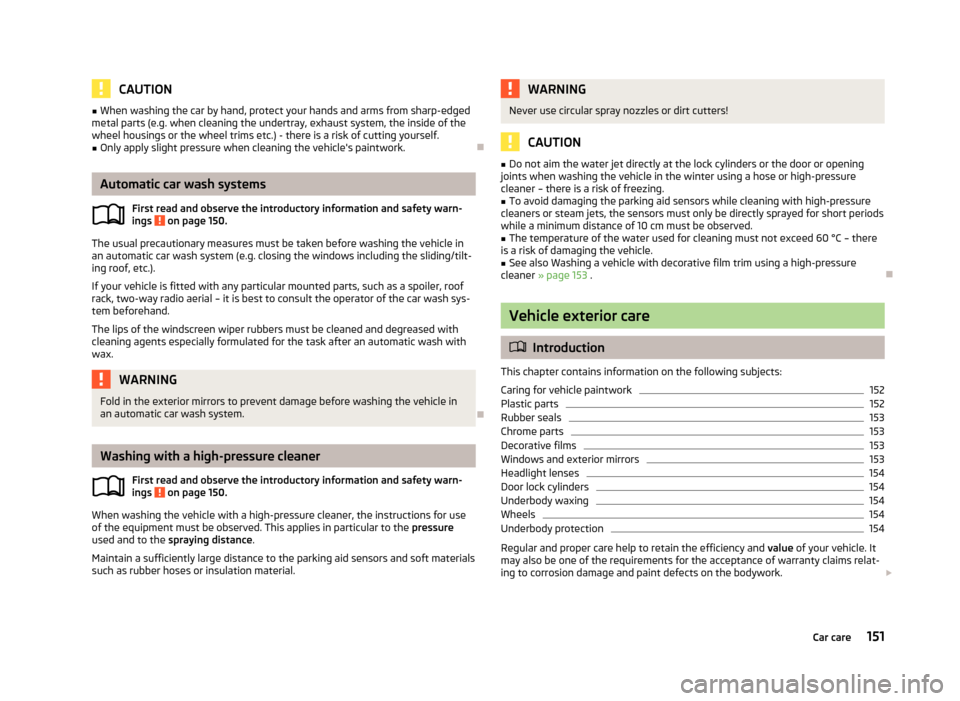
CAUTION■When washing the car by hand, protect your hands and arms from sharp-edged
metal parts (e.g. when cleaning the undertray, exhaust system, the inside of the
wheel housings or the wheel trims etc.) - there is a risk of cutting yourself.■
Only apply slight pressure when cleaning the vehicle's paintwork.
Automatic car wash systems
First read and observe the introductory information and safety warn-
ings
on page 150.
The usual precautionary measures must be taken before washing the vehicle in
an automatic car wash system (e.g. closing the windows including the sliding/tilt-
ing roof, etc.).
If your vehicle is fitted with any particular mounted parts, such as a spoiler, roof
rack, two-way radio aerial – it is best to consult the operator of the car wash sys-
tem beforehand.
The lips of the windscreen wiper rubbers must be cleaned and degreased with
cleaning agents especially formulated for the task after an automatic wash with
wax.
WARNINGFold in the exterior mirrors to prevent damage before washing the vehicle in
an automatic car wash system.
Washing with a high-pressure cleaner
First read and observe the introductory information and safety warn-
ings
on page 150.
When washing the vehicle with a high-pressure cleaner, the instructions for use
of the equipment must be observed. This applies in particular to the pressure
used and to the spraying distance .
Maintain a sufficiently large distance to the parking aid sensors and soft materials
such as rubber hoses or insulation material.
WARNINGNever use circular spray nozzles or dirt cutters!
CAUTION
■ Do not aim the water jet directly at the lock cylinders or the door or opening
joints when washing the vehicle in the winter using a hose or high-pressure
cleaner – there is a risk of freezing.■
To avoid damaging the parking aid sensors while cleaning with high-pressure
cleaners or steam jets, the sensors must only be directly sprayed for short periods
while a minimum distance of 10 cm must be observed.
■
The temperature of the water used for cleaning must not exceed 60 °C – there
is a risk of damaging the vehicle.
■
See also Washing a vehicle with decorative film trim using a high-pressure
cleaner » page 153 .
Vehicle exterior care
Introduction
This chapter contains information on the following subjects:
Caring for vehicle paintwork
152
Plastic parts
152
Rubber seals
153
Chrome parts
153
Decorative films
153
Windows and exterior mirrors
153
Headlight lenses
154
Door lock cylinders
154
Underbody waxing
154
Wheels
154
Underbody protection
154
Regular and proper care help to retain the efficiency and value of your vehicle. It
may also be one of the requirements for the acceptance of warranty claims relat- ing to corrosion damage and paint defects on the bodywork.
151Car care
Page 155 of 223
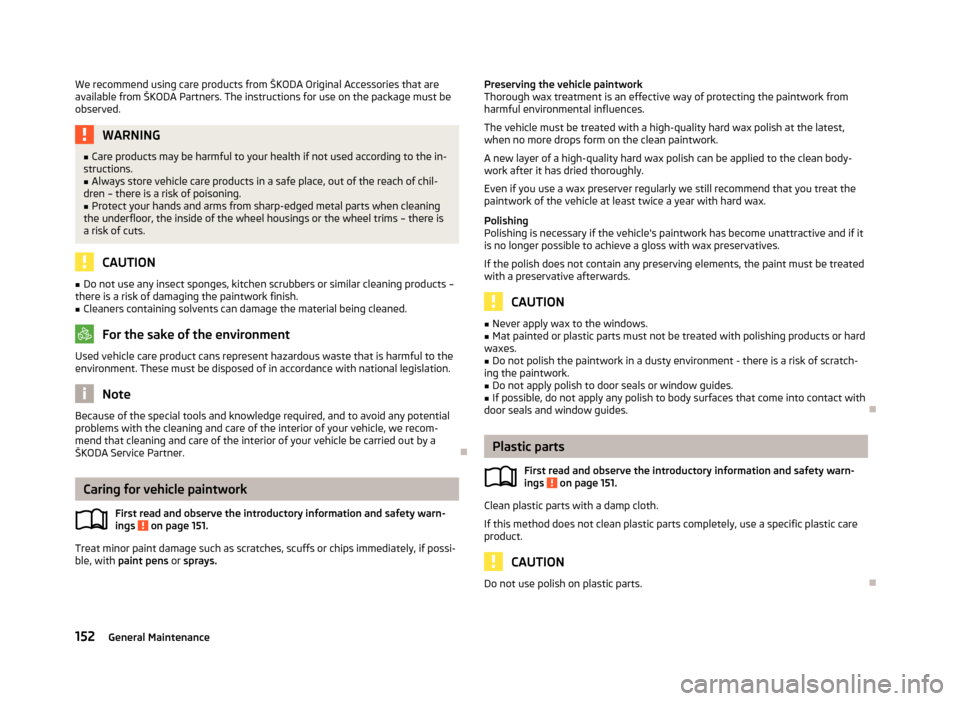
We recommend using care products from ŠKODA Original Accessories that are
available from ŠKODA Partners. The instructions for use on the package must be
observed.WARNING■ Care products may be harmful to your health if not used according to the in-
structions.■
Always store vehicle care products in a safe place, out of the reach of chil-
dren – there is a risk of poisoning.
■
Protect your hands and arms from sharp-edged metal parts when cleaning
the underfloor, the inside of the wheel housings or the wheel trims – there is
a risk of cuts.
CAUTION
■ Do not use any insect sponges, kitchen scrubbers or similar cleaning products –
there is a risk of damaging the paintwork finish.■
Cleaners containing solvents can damage the material being cleaned.
For the sake of the environment
Used vehicle care product cans represent hazardous waste that is harmful to the
environment. These must be disposed of in accordance with national legislation.
Note
Because of the special tools and knowledge required, and to avoid any potential
problems with the cleaning and care of the interior of your vehicle, we recom-
mend that cleaning and care of the interior of your vehicle be carried out by a
ŠKODA Service Partner.
Caring for vehicle paintwork
First read and observe the introductory information and safety warn-ings
on page 151.
Treat minor paint damage such as scratches, scuffs or chips immediately, if possi-
ble, with paint pens or sprays.
Preserving the vehicle paintwork
Thorough wax treatment is an effective way of protecting the paintwork from
harmful environmental influences.
The vehicle must be treated with a high-quality hard wax polish at the latest,
when no more drops form on the clean paintwork.
A new layer of a high-quality hard wax polish can be applied to the clean body-
work after it has dried thoroughly.
Even if you use a wax preserver regularly we still recommend that you treat the
paintwork of the vehicle at least twice a year with hard wax.
Polishing
Polishing is necessary if the vehicle's paintwork has become unattractive and if it
is no longer possible to achieve a gloss with wax preservatives.
If the polish does not contain any preserving elements, the paint must be treatedwith a preservative afterwards.
CAUTION
■ Never apply wax to the windows.■Mat painted or plastic parts must not be treated with polishing products or hard
waxes.■
Do not polish the paintwork in a dusty environment - there is a risk of scratch-
ing the paintwork.
■
Do not apply polish to door seals or window guides.
■
If possible, do not apply any polish to body surfaces that come into contact with
door seals and window guides.
Plastic parts
First read and observe the introductory information and safety warn-ings
on page 151.
Clean plastic parts with a damp cloth.
If this method does not clean plastic parts completely, use a specific plastic care product.
CAUTION
Do not use polish on plastic parts.
152General Maintenance
Page 157 of 223
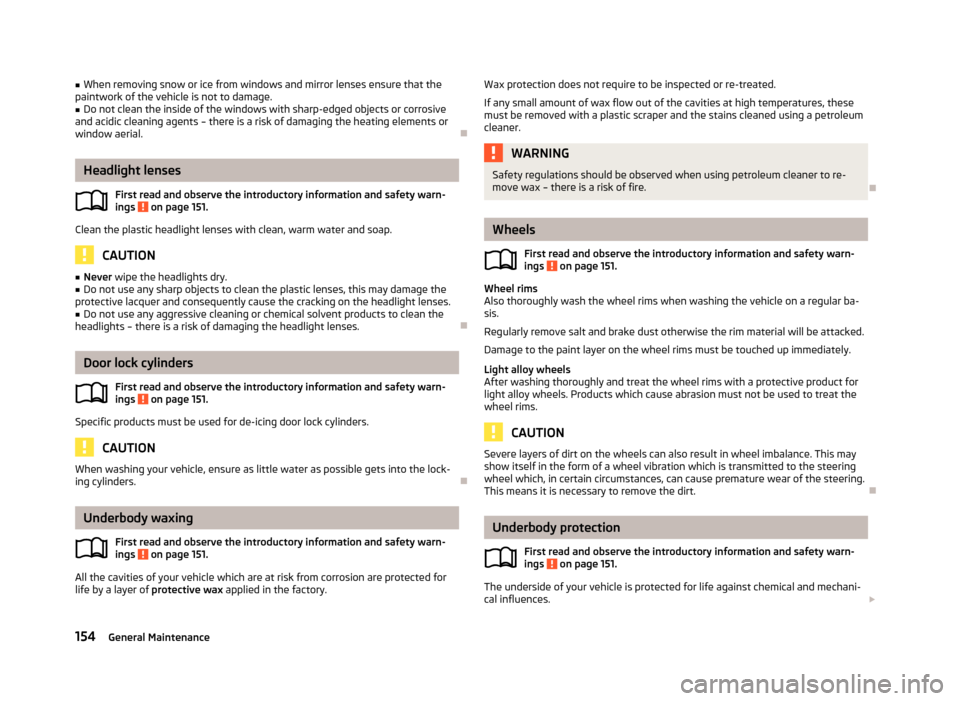
■When removing snow or ice from windows and mirror lenses ensure that the
paintwork of the vehicle is not to damage.■
Do not clean the inside of the windows with sharp-edged objects or corrosive
and acidic cleaning agents – there is a risk of damaging the heating elements or
window aerial.
Headlight lenses
First read and observe the introductory information and safety warn-ings
on page 151.
Clean the plastic headlight lenses with clean, warm water and soap.
CAUTION
■ Never wipe the headlights dry.■Do not use any sharp objects to clean the plastic lenses, this may damage the
protective lacquer and consequently cause the cracking on the headlight lenses.■
Do not use any aggressive cleaning or chemical solvent products to clean the
headlights – there is a risk of damaging the headlight lenses.
Door lock cylinders
First read and observe the introductory information and safety warn-
ings
on page 151.
Specific products must be used for de-icing door lock cylinders.
CAUTION
When washing your vehicle, ensure as little water as possible gets into the lock-
ing cylinders.
Underbody waxing
First read and observe the introductory information and safety warn-
ings
on page 151.
All the cavities of your vehicle which are at risk from corrosion are protected for life by a layer of protective wax applied in the factory.
Wax protection does not require to be inspected or re-treated.
If any small amount of wax flow out of the cavities at high temperatures, these must be removed with a plastic scraper and the stains cleaned using a petroleum cleaner.WARNINGSafety regulations should be observed when using petroleum cleaner to re-
move wax – there is a risk of fire.
Wheels
First read and observe the introductory information and safety warn-
ings
on page 151.
Wheel rims
Also thoroughly wash the wheel rims when washing the vehicle on a regular ba- sis.
Regularly remove salt and brake dust otherwise the rim material will be attacked.
Damage to the paint layer on the wheel rims must be touched up immediately.
Light alloy wheels
After washing thoroughly and treat the wheel rims with a protective product for
light alloy wheels. Products which cause abrasion must not be used to treat the
wheel rims.
CAUTION
Severe layers of dirt on the wheels can also result in wheel imbalance. This may
show itself in the form of a wheel vibration which is transmitted to the steering
wheel which, in certain circumstances, can cause premature wear of the steering.
This means it is necessary to remove the dirt.
Underbody protection
First read and observe the introductory information and safety warn-ings
on page 151.
The underside of your vehicle is protected for life against chemical and mechani-
cal influences.
154General Maintenance